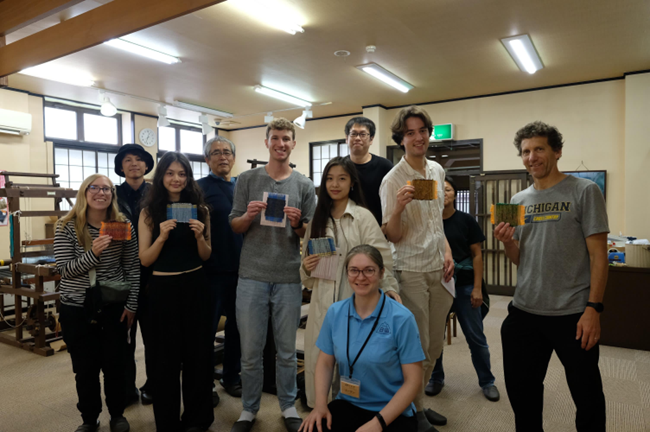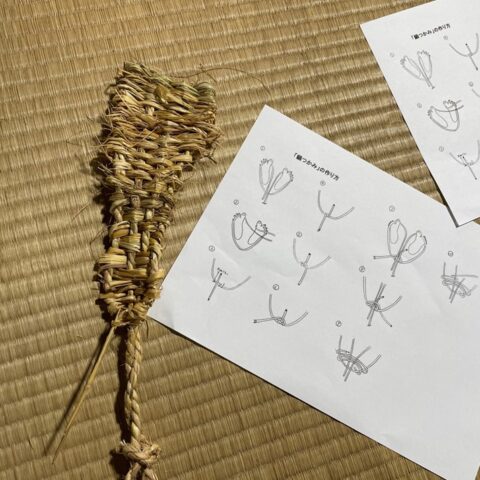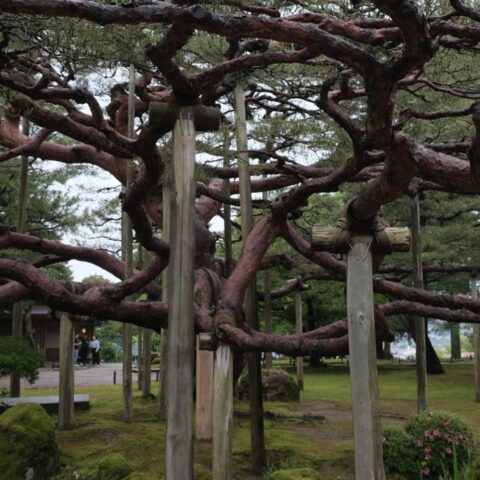Researcher Training Program in Kanazawa & Shiramine
The learning I experienced in the program did not only come from lectures but also experiencing and seeing for myself.

現地の人との交流について印象に残ったことは?
How was your experience interacting with local people?
The teachers at Kanazawa University were incredibly welcoming and accommodated everyone in the program extremely well. A lot of interaction with local people occurred during the field trip to Shiramine, where we truly talked and did many activities with residents there. Most local people we met were elderlies, which reflects what we have learned about Shiramine—that the younger people all tend to move to bigger cities and that the village is most populated by elders. When we visited the community center, we met many of the elderly residents and they kindly offered us tea, coffee, and snacks. Thanks to our guide Mr. Takashi and Susan who acted as translators, we were able to learn from them the changes that Shiramine has seen through the past years and what their time looked like. One senior gentleman talked about how when he was young, he lived off lumbering, but unfortunately in the current society where inflation and technologic advancement happens rapidly, it is hard to sustain a simple life like that. It is also important to note that we learned lots from our guide Mr. Takashi, who, provided the most information regarding Shiramine’s culture, biodiversity, and people. A fun photo activity where we each shared some photos, we took of Shiramine facilitated some great discussion between Mr. Takashi and us, where we were able to exchange the views of an insider and outsider on a village town like Shiramine. For example, many of us who did not come from a city within the mountains would pay much attention to the green and the waters of Shiramine, while someone like Mr. Takashi would think it was normal. This was also a great opportunity to discuss many similarities and differences between Japan, Shiramine, and many other places we came from. Mr. Takashi also hosted a dinner gathering where we all discussed the potential of cultural exchange through simply sitting down and eating at the same table, which I believe was an amazing idea speaking from my own participation in such a gathering.
To conclude, I believe interacting with local people in of itself is incredibly important when engaging with a new culture/society and I have learned so much from the exchange of ideas and perspectives from people that live in a different culture and environment.
プログラム期間中の活動で特に印象に残ったこと
Please write about what left a strong impression on you during the program period.
During the Kanazawa program period, a one-day field trip exploring historic and cultural sites of Kanazawa City left the strongest impression on me. My group visited the Kanazawa Castle, Kenroku-en Garden, and two Samurai gardens. This trip involves a lot of appreciation for the beauty of the architectures and garden designs, but also allowed me to learn a lot about Kanazawa’s history and the unique water channel system of the city. Both the Kanazawa Castle and Kenroku-en taught me how the architecture and garden designs in Kanazawa reflects the idea that the people live with nature and support one another—using different local wood according to their unique characteristics to fit an architectural function and using structures to support the trees in Kenroku-en as winter snow and extreme weathers might damage the tree branches. Nature was such an integrated part into the local culture and these designs made that evident. It was also eye-opening to see Kanazawa City still actively preserved and use the water channel system from the rivers to water the Samurai gardens, the Castle, and Kenroku-en. Many times even just walking in the streets one hears the water flowing, reflecting how this natural element is important and part of the everyday lives of Kanazawa people.
For the Shiramine program, I vividly remember my experience of learning several traditional crafts including straw weaving and the use of silk and making ushikubi tsumugi—the traditional fabric produced in Shiramine. We each made our own coasters from strips of straw that are also used in making straw hats, and it was impressive how the local people use such techniques in various ways to create so many different items stemming from hats to even jewelry and art pieces. We also learned how to use strips of straw to make shoes/potholders. This process involved us sitting down and using our body parts, especially our feet to pull the final product together, which was a unique experience and taught me about how the local people used to and still continue to use traditional techniques and simple materials to make everyday items. Similarly, we were able to visit the silk factory and witness the highly skilled workers obtain silk threads from silkworm cocoons and weave them into the ushikubi tsumugi. We also each experienced the machine used to create a coaster. Having experienced the process ourselves, I was amazed at how skilled the workers are as the weaving is quite difficult—one needs to incorporate the whole body, including both hands and feet, and requires a lot of focus and coordination. It was truly an unforgettable experience to witness but also participate in a side of Shiramine that is artistic, creative, and cultural. Having experienced the processes myself, I also learned to appreciate the work of such productions even more.
From the overall experience, I was learning about a way of life that values nature and environment, co-existence with nature. Although it is sad to learn that many traditional craft techniques and cultural aspects are disappearing, I am very inspired by the people that strive to preserve tradition and culture, and the experience showed me a different way of seeing “living” than just achieving societal goals.
プログラム中の経験で将来のキャリアのために役立つと思うこと
What was a useful experience for your future career among your experiences during the program?
As someone majoring in International Relations, having learned about many facets of how a city like Kanazawa operates is useful knowledge reflecting many social issues. The way Kanazawa City prioritizes cultural sustainability is something that can be applied world-wide to many places seeing decline in cultural and traditional practices. I was also able to learn and observe first-hand the effects of urbanization, which is a global phenomenon, also present in Kanazawa and Japan when seeing the elderlies of Shiramine and Mr. Takashi talk about the young people migrating to cities leaving their suburban hometowns behind.
As someone who might work with people from different cultures and even move overseas for a job, the communication with people from the program and the local people would become valuable experiences. As mentioned before, I also learned a lot about facilitating and participating in productive knowledge exchanges rather than one-sided communication and learning.
次年度以降、同じプログラムに参加する学生に伝えたいこと
Comments for students who will participate in the same program next year.
I would highly recommend the future participants to use this opportunity to talk with the local people and their local guide/professors/teachers as I believe I gained some of the most valuable exchanges from discussing the different cultures we all come from and talk about similarities and differences, and most importantly, to learn from Kanazawa and Shiramine people and understand their perspectives. There is also much to learn from regarding the way Kanazawa and Shiramine people preserve their culture and traditions. The people I have met in Kanazawa and Shiramine, like our guide Mr. Takashi and a student from Kanazawa University named Kyoko, were also curious people that hope for us to provide our thoughts and perspectives, so I believe it is important to keep in mind that the learning is very much mutual and there will be many productive cultural exchanges during the program rather than a one-sided learning experience. Lastly just to briefly mention the Japanese language, I think this is also a great opportunity to learn basic Japanese and polite ways of greeting and communicating with people.
渡航前・渡航後のCOILを含め、プログラム全体を通しての感想
Feedback on the program, including COILs before and after trips to the US/Japan.
Before the trip I didn’t know what to expect and I was especially surprised about how much I was able to experience hands-on including the interactions in both formal and informal settings with our guides and professors, which both contributed greatly to my learning. As previously mentioned, practicing local craft at Shiramine also introduced me to the way of life and creative side of the Shiramine people. The program has definitely widened my vision on Kanazawa’s unique biocultural diversity and its various traditional crafts/architectures. The learning I experienced in the program did not only come from lectures but also experiencing and seeing for myself, applying what I learned to what is present, which in my opinion contributed to greater depth in my understanding and thinking.

Making potholders using a traditional technique and straw at Shiramine

Tree-supporting systems in Kenroku-en Garden reflecting the mutual support between human and nature in Kanazawa culture.
